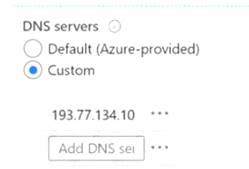- (Exam Topic 6)
You have an Azure subscription that contains the Azure virtual machines shown in the following table.
You configure the network interfaces of the virtual machines to use the settings shown in the following table
From the settings of VNET1, you configure the DNS servers shown in the following exhibit.
The virtual machines can successfully connect to the DNS server that has an IP address of 192.168.10.15 and the DNS server that has an IP address of 193.77.134.10.
For each of the following statements, select Yes if the statement is true. Otherwise, select No.
Solution:
Box 1: Yes
You can specify DNS server IP addresses in the VNet settings. The setting is applied as the default DNS server(s) for all VMs in the VNet.
Box 2: No
You can set DNS servers per VM or cloud service to override the default network settings. Box 3: Yes
You can set DNS servers per VM or cloud service to override the default network settings. Reference:
https://docs.microsoft.com/en-us/azure/virtual-network/virtual-networks-faq#name-resolution-dns
Does this meet the goal?
Correct Answer:A
- (Exam Topic 6)
You are troubleshooting a performance issue for an Azure Application Gateway.
You need to compare the total requests to the failed requests during the past six hours. What should you use?
Correct Answer:A
Application Gateway currently has seven metrics to view performance counters.
Metrics are a feature for certain Azure resources where you can view performance counters in the portal. For Application Gateway, the following metrics are available: Total Requests
Total Requests  Failed Requests
Failed Requests Current Connections
Current Connections  Healthy Host Count
Healthy Host Count  Response Status
Response Status Throughput
Throughput Unhealthy Host count
Unhealthy Host count
You can filter on a per backend pool basis to show healthy/unhealthy hosts in a specific backend pool References: https://docs.microsoft.com/en-us/azure/application-gateway/application-gatewaydiagnostics# Metrics
- (Exam Topic 6)
Note: This question is part of a series of questions that present the same scenario. Each question in the series contains a unique solution that might meet the stated goals. Some question sets might have more than one correct solution, while others might not have a correct solution.
After you answer a question in this section, you will NOT be able to return to it. As a result, these questions will not appear in the review screen.
You have an Azure web app named App1. App1 runs in an Azure App Service plan named Plan1. Plan1 is associated to the Free pricing tier.
You discover that App1 stops each day after running continuously for 60 minutes. You need to ensure that App1 can run continuously for the entire day.
Solution: You add a continuous WebJob to App1. Does this meet the goal?
Correct Answer:B
A web app can time out after 20 minutes of inactivity. Only requests to the actual web app reset the timer. Viewing the app's configuration in the Azure portal or making requests to the advanced tools site (https://<app_name>.scm.azurewebsites.net) don't reset the timer. If your app runs continuous or scheduled (Timer trigger) WebJobs, enable Always On to ensure that the WebJobs run reliably. This feature is availabl only in the Basic, Standard, and Premium pricing tiers.
The app service plan mentioned in the question is associated to the free tier , so addition of a continuous WebJob to App1 is not possible. So the proposed solution won't meet the goal.
Reference :
https://docs.microsoft.com/en-us/azure/app-service/webjobs-create
- (Exam Topic 4)
You have an Azure subscription that contains the following resources:  100 Azure virtual machines
100 Azure virtual machines 20 Azure SQL databases
20 Azure SQL databases  50 Azure file shares
50 Azure file shares
You need to create a daily backup of all the resources by using Azure Backup. What is the minimum number of backup policies that you must create?
Correct Answer:C
There is a limit of 100 VMs that can be associated to the same backup policy from portal. We recommend that for more than 100 VMs, create multiple backup policies with same schedule or different schedule.
One policy for VMS, one for SQL databases, and one for the file shares. References:
https://docs.microsoft.com/en-us/azure/backup/backup-azure-vm-backup-faq
- (Exam Topic 5)
You have an Azure Storage account named storage1. You plan to use AzCopy to copy data to storage1.
You need to identify the storage services in storage1 to which you can copy the data. What should you identify?
Correct Answer:B
AzCopy is a command-line utility that you can use to copy blobs or files to or from a storage account. Reference:
https://docs.microsoft.com/en-us/azure/storage/common/storage-use-azcopy-v10